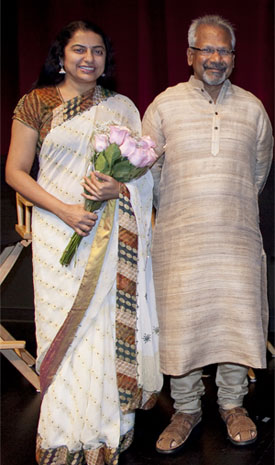
| Reviews |
| rediff.com The crisis manager in Mani Ratnam's life! November 20, 2010 |
In New York, Arthur J Pais meets the First Couple of South Indian cinema: Mani and Suhasini Ratnam.
Arthur J Pais in New York
He responded to questions posed by New York University Professor Richard Allen, an expert on Alfred Hitchcock, who in the past 10 years has evinced keen interest in Indian films. Allen asked the filmmaker about the visuals and atmosphere in his movies, the use of mist, rain and occasionally, snow. If people say natural elements enhance the film's storytelling, then he will take the credit for those scenes, Ratnam said. Otherwise, you have to blame Kurosawa, he added, chuckling. Ratnam said from the time he saw Rashomon over 25 years ago, that and many other Kurosawa films have showed him the importance of atmosphere in cinema. He also learned, Ratnam added, that good films need not shy away from showing emotions. Professor Allen told a Huffington Post blogger: 'Ravaan is a natural development out of Ratnam's work up to this point, both in its production and story. For some time now, Ratnam, a Tamil director, has been making Hindi films, and this reworking of the story of Raavan from the Ramayana [ Images ], shot in both Hindi and Tamil, allows him to explore his abiding concerns with social justice and morality, the will to power and redemption through love, on an epic scale.' 'It also showcases Ratnam's remar.kable facility with the rich expressive vocabulary of popular Indian cinema which makes him one of the most important directors in world cinema,' Allen added. Allen asked Ratnam at the post-screening discussion about the Ravan-like character, and the filmmaker said he relied a lot on the Kamaba Ramayan. In that version of the epic, Ravan is on the wrong side. But it made more space than other Ramayana versions to show Ravan's better qualities, his intellectual powers, and his interest in the arts. How do the Ratnams work together? Allen asked. Suhasini Ratnam, who continues to act in half a dozen films in a year, is also involved in women's welfare activities in Chennai. She is a partner in Madras Talkies, which has produced over a dozen films with her husband as producer and director in most cases. She said, without elaboration, that she often serves as a "crisis manager." She and her husband often discuss films in their planning stages at their Chennai home. She comes up with suggestions and some of them make their way into the film. She thought a particular scene with Aishwarya Rai Bachchan [ Images ] would look very good if she was shown underwater at first. She even thought she could get very good underwater cameras for filming. Her husband did not seem keen. Later, the scene did materialise when Aishwarya plunges into the water from a great height.
Mani Ratnam has been feted at many film festivals around the world like the Toronto International Film Festival and the oldest film festival, the 68-year-old Venice Film Festival. At the MIAAC film festival in New York, the director received a huge welcome. Even though Raavan was a flop in India [ Images ], it received a warm welcome in New York. Some viewers, who had seen the Hindi version before, discovered that it was 'an entirely new film, a very authentic film filled with raw emotions.' Raavan was shown as part of the Chalo Chennai sidebar to the MIAAC festival. Acchamundu! Acchamundu1 (I am Scared) from New Jersey -- based on Arun Vaidyanathan -- was also screened during the Chalo Chennai event. The MIAAC festival will be held next May instead of November because there are too many South Asia-oriented festivals held in New York in November. The festival will be held in partnership with the Film Society at the Lincoln Centre, a well-known New York institution. Images: Top: Mani and Suhasini Ratnam. Bottom, right: Mani Ratnam is felicitated by H R Shah, chairman of the New York-based TV Asia network. Photographs: Michael Toolan |
| Source: http://www.rediff.com/movies/special/mani-ratnams-crisis-manager/20101119.htm |
 A few minutes after he walked the red carpet at a New York theatre along with his wife Suhasini, who is also his production and writing partner, filmmaker Mani Ratnam waited for the lights to dim and the screen light up with his Raavan.
A few minutes after he walked the red carpet at a New York theatre along with his wife Suhasini, who is also his production and writing partner, filmmaker Mani Ratnam waited for the lights to dim and the screen light up with his Raavan. Suhasini said with a chuckle she would learn that Ratnam had that scene in mind while they were discussing various ideas at their home.
Suhasini said with a chuckle she would learn that Ratnam had that scene in mind while they were discussing various ideas at their home.